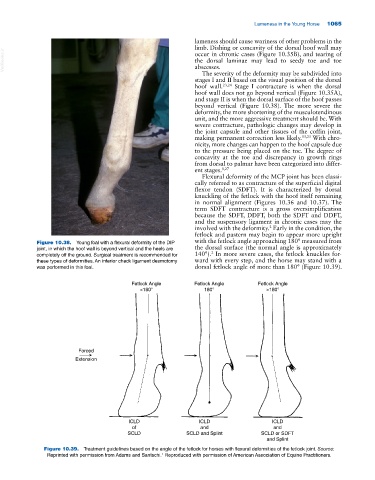Page 1099 - Adams and Stashak's Lameness in Horses, 7th Edition
P. 1099
Lameness in the Young Horse 1065
lameness should cause wariness of other problems in the
limb. Dishing or concavity of the dorsal hoof wall may
VetBooks.ir the dorsal laminae may lead to seedy toe and toe
occur in chronic cases (Figure 10.35B), and tearing of
abscesses.
The severity of the deformity may be subdivided into
stages I and II based on the visual position of the dorsal
hoof wall. 23,24 Stage I contracture is when the dorsal
hoof wall does not go beyond vertical (Figure 10.35A),
and stage II is when the dorsal surface of the hoof passes
beyond vertical (Figure 10.38). The more severe the
deformity, the more shortening of the musculotendinous
unit, and the more aggressive treatment should be. With
severe contracture, pathologic changes may develop in
the joint capsule and other tissues of the coffin joint,
making permanent correction less likely. 13,23 With chro
nicity, more changes can happen to the hoof capsule due
to the pressure being placed on the toe. The degree of
concavity at the toe and discrepancy in growth rings
from dorsal to palmar have been categorized into differ
ent stages. 8,27
Flexural deformity of the MCP joint has been classi
cally referred to as contracture of the superficial digital
flexor tendon (SDFT). It is characterized by dorsal
knuckling of the fetlock with the hoof itself remaining
in normal alignment (Figures 10.36 and 10.37). The
term SDFT contracture is a gross oversimplification
because the SDFT, DDFT, both the SDFT and DDFT,
and the suspensory ligament in chronic cases may the
2
involved with the deformity. Early in the condition, the
fetlock and pastern may begin to appear more upright
Figure 10.38. Young foal with a flexural deformity of the DIP with the fetlock angle approaching 180° measured from
joint, in which the hoof wall is beyond vertical and the heels are the dorsal surface (the normal angle is approximately
2
completely off the ground. Surgical treatment is recommended for 140°). In more severe cases, the fetlock knuckles for
these types of deformities. An inferior check ligament desmotomy ward with every step, and the horse may stand with a
was performed in this foal. dorsal fetlock angle of more than 180° (Figure 10.39).
Fetlock Angle Fetlock Angle Fetlock Angle
<180° 180° >180°
Forced
Extension
ICLD ICLD ICLD
of and and
SCLD SCLD and Splint SCLD or SDFT
and Splint
Figure 10.39. Treatment guidelines based on the angle of the fetlock for horses with flexural deformities of the fetlock joint. Source:
1
Reprinted with permission from Adams and Santschi. Reproduced with permission of American Association of Equine Practitioners.

